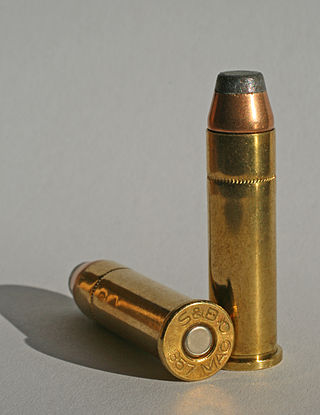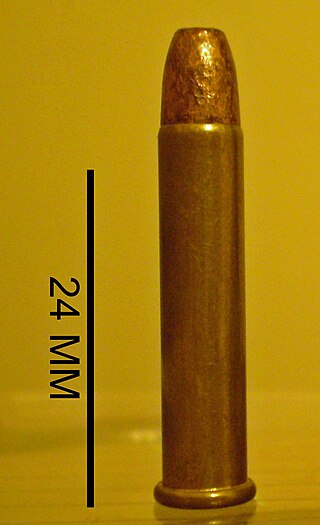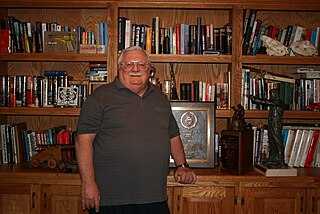Related Research Articles

A cartridge, also known as a round, is a type of pre-assembled firearm ammunition packaging a projectile, a propellant substance and an ignition device (primer) within a metallic, paper, or plastic case that is precisely made to fit within the barrel chamber of a breechloading gun, for convenient transportation and handling during shooting. Although in popular usage the term "bullet" is often used to refer to a complete cartridge, the correct usage only refers to the projectile.

The .38 Special, also commonly known as .38 S&W Special, .38 Smith & Wesson Special, .38 Spl, .38 Spc, or 9x29mmR is a rimmed, centerfire cartridge designed by Smith & Wesson.

The .50 BMG, also known as 12.7×99mm NATO, and designated as the 50 Browning by the C.I.P., is a .50 in (12.7 mm) caliber cartridge developed for the M2 Browning heavy machine gun in the late 1910s, entering official service in 1921. Under STANAG 4383, it is a standard service cartridge for NATO forces, as well as many non-NATO countries. The cartridge itself has been made in many variants: multiple generations of regular ball, tracer, armor-piercing (AP), incendiary, and saboted sub-caliber rounds. The rounds intended for machine guns are made into a continuous ammunition belt using metallic links.
Winchester rifle is a comprehensive term describing a series of lever action repeating rifles manufactured by the Winchester Repeating Arms Company. Developed from the 1860 Henry rifle, Winchester rifles were among the earliest repeaters. The Model 1873 was particularly successful, being marketed by the manufacturer as "The Gun That Won the West".

A center-fire is a type of metallic cartridge used in firearms, where the primer is located at the center of the base of its casing. Unlike rimfire cartridges, the centerfire primer is typically a separate component seated into a recessed cavity in the case head and is replaceable by reloading the cartridge.

A rim-fire is a type of metallic cartridge used in firearms, where the primer is located within a hollow circumferential rim protruding from the base of its casing. When fired, the gun's firing pin will strike and crush the rim against the edge of the barrel breech, sparking the primer compound within the rim, and in turn ignite the propellant within the case. Invented in 1845, by Louis-Nicolas Flobert, the first rimfire metallic cartridge was the .22 BB Cap cartridge, which consisted of a percussion cap with a bullet attached to the top. While many other different cartridge priming methods have been tried since the early 19th century, such as teat-fire and pinfire, only small caliber rimfire and centerfire cartridges have survived to the present day with regular use. The .22 Long Rifle rimfire cartridge, introduced in 1887, is by far the most common ammunition found in the world today in terms of units manufactured and sold.

.22 BB Cap, also known as the 6mm Flobert, is a variety of .22 caliber rimfire ammunition. Invented by Louis-Nicolas Flobert in 1845, it was the first rimfire metallic cartridge. The .22 BB Cap and .22 CB Cap are interchangeable and are relatively quiet low velocity cartridges, designed for indoor target shooting.

.22 Short is a variety of .22 caliber (5.6 mm) rimfire ammunition. Developed in 1857 for the first Smith & Wesson revolver, the .22 rimfire was the first American metallic cartridge. The original loading was a 29 or 30 gr bullet and 4 gr of black powder. The original .22 rimfire cartridge was renamed .22 Short with the introduction of the .22 Long in 1871.

The .22 Long is a variety of .22 caliber (5.6 mm) rimfire ammunition. The .22 Long is the second-oldest of the surviving rimfire cartridges, dating back to 1871, when it was loaded with a 29 gr (1.9 g) bullet and 5 gr (0.32 g) of black powder, 25% more than the .22 Short on which it was based. It was designed for use in revolvers, but was soon chambered in rifles as well, in which it gained a reputation as a small game cartridge.

The .32 S&W cartridge was introduced in 1878 for Smith & Wesson pocket revolvers. It was originally designed as a black powder cartridge. The .32 S&W was offered to the public as a light defense cartridge for "card table" distances.

The .32 S&W Long, also known as 7.65x23mm, is a straight-walled, centerfire, rimmed handgun cartridge, based on the earlier .32 S&W cartridge. It was introduced in 1896 for Smith & Wesson's first-model Hand Ejector revolver. Colt called it the .32 Colt New Police in revolvers it made chambered for the cartridge.
The .256 Winchester Magnum is a firearms cartridge developed by Winchester, and was produced by necking-down a .357 Magnum cartridge to .257 diameter. It was designed for shooting small game and varmints.

The .22 Hornet or 5.6×36mmR Hornet is a varminting, small-game hunting, survival and competition centerfire rifle cartridge commercially introduced in 1930. It is considerably more powerful than the rimfire .22 WMR and the .17 HMR, achieving higher velocity with a bullet twice the weight of the .17 HMR bullet. The Hornet also differs significantly from these in that being a centerfire cartridge makes it reloadable, and thus more versatile. It was the smallest commercially available .22 caliber centerfire cartridge until the introduction of the FN 5.7×28mm.

The .22 Winchester Magnum Rimfire, also known as the .22 WMR, .22 Magnum, .22 WMRF, .22 MRF, or .22 Mag, is a rimfire cartridge. Originally loaded with a bullet weight of 40 grains (2.6 g) delivering velocities in the 2,000 feet per second (610 m/s) range from a rifle barrel, .22 WMR is now loaded with bullet weights ranging from 50 grains (3.2 g) at 1,530 feet per second (470 m/s) to 30 grains (1.9 g) at 2,200 feet per second (670 m/s).
The Winchester Model 1894 rifle is a lever-action repeating rifle that became one of the most famous and popular hunting rifles of all time. It was designed by John Browning in 1894 and originally chambered to fire two metallic black powder cartridges, the .32-40 Winchester and .38-55 Winchester. It was the first rifle to chamber the smokeless powder round, the .30 WCF in 1895. In 1901, Winchester created the new .32 Winchester Special caliber with production of rifles starting in 1902.

The .22 Spitfire is an American wildcat rifle cartridge developed by Col. Melvin M. Johnson. It was originally named the MMJ 5.7mm by its designer and is also known in the U.S. as the 5.7mm Johnson, the Johnson MMJ 5.7mm Spitfire, and the .22 Johnson,.

J. D. Jones is an American firearms and cartridge designer, firearms writer and founder of SSK Industries. Jones began hunting at an early age, and became interested in bullet casting and handloading firearms cartridges. In the 1960s, Jones collaborated with Lee Jurras to create the Super Vel line of high-performance handgun ammunition.

The .45-60 Winchester is a centerfire rifle cartridge intended for 19th-century big-game hunting. Nomenclature of the era indicated the .45-60 cartridge contained a 0.45-inch (11.43 mm) diameter bullet with 60 grains (3.89 g) of black powder. Winchester Repeating Arms Company shortened the .45-70 Government cartridge to operate through the Winchester Model 1876 rifle's lever-action.

The .40-60 Winchester is a rimmed, bottlenecked centerfire rifle cartridge designed for use in lever-action rifles by Winchester Repeating Arms Company in 1884.

Major Ned H. Roberts, was an American hunter, competition target shooter, gun writer & editor, ballistician and firearms experimenter. Roberts was a prolific contributor to sporting publications, including Outdoor Life, Outers, Arms and the Man (later renamed as American Rifleman, and to Hunting and Fishing magazine, for which latter publication he served as Firearms Editor. His work on cartridge design in collaboration with Adolph Otto Niedner, Franklin Weston Mann, Townsend Whelen, and F.J. Sage led to a commercialized version of his own original .25-caliber wildcat cartridge introduced by Remington in 1934 and named the .257 Roberts.
References
- ↑ American Rifleman. The National Rifle Association of America. 1922. p. 204.
- ↑ American Rifleman. National Rifle Association of America. 1906. p. 509.
- ↑ The Bullet's Flight from Powder to Target: The Internal and External Ballistics of Small Arms; a Study of Rifle Shooting with the Personal Element Excluded, Disclosing the Cause of the Error at Target. Munn & Company. 1909.
- ↑ Terry Wieland (1 March 2012). Gun Digest Presents Classic Sporting Rifles. Gun Digest Books. pp. 101–. ISBN 1-4402-3003-X.